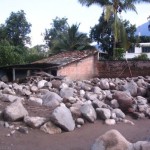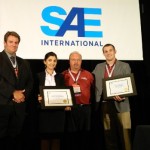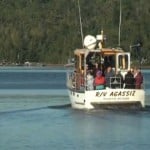 In October 2011, heavy rainfall poured down the sides of El Salvador’s San Vicente Volcano, nearly four feet of water in 12 days. Coffee plantation employees, working high up on the volcano’s slope began noticing surface cracks forming on steep slopes and in coffee plantations. Cracks herald landslides—places where the wet, heavy upper layers, saturated with water, slide over the less-permeable rocky layers underneath. The workers radioed downslope, keeping close tabs on the rainfall gauge network.
In October 2011, heavy rainfall poured down the sides of El Salvador’s San Vicente Volcano, nearly four feet of water in 12 days. Coffee plantation employees, working high up on the volcano’s slope began noticing surface cracks forming on steep slopes and in coffee plantations. Cracks herald landslides—places where the wet, heavy upper layers, saturated with water, slide over the less-permeable rocky layers underneath. The workers radioed downslope, keeping close tabs on the rainfall gauge network.
Read More
 Troy Bouman reaches over, presses play, and the loudspeaker sitting on the desk starts playing the university fight song. But this is no ordinary loudspeaker. This is a carbon nanotube transducer—and it makes sound with heat.
Troy Bouman reaches over, presses play, and the loudspeaker sitting on the desk starts playing the university fight song. But this is no ordinary loudspeaker. This is a carbon nanotube transducer—and it makes sound with heat.
Read More
The beauty and bounty of Lake Superior was celebrated Sunday at the Third Annual Lake Superior Day in Copper Harbor. Community volunteers, along with the Lake Superior Stewardship Initiative, organized the festival with lots of special activities at the 6th Street Dock along the Copper Harbor Boardwalk. Activities included:
Community picnic
Canoe races and kayak demonstrations
Interactive art (paint the model freighter)
Remotely-Operated-Vehicle demonstrations by Tech’s Great Lakes Research Center
Presentation on the health of Lake Superior by Great Lakes scientist Martin Auer (CEE)
Live music, poetry and more
From 1-4 p.m. a special highlight was the opportunity for festival attendees to find out how scientists study the Great Lakes by taking a 40-minute scientific excursion aboard Michigan Tech’s research vessel, Agassiz. The excursions are part of the Ride the Waves Program funded by a grant from General Motors.
Lake Superior Day is celebrated throughout the Lake Superior basin on or close to the third Sunday in July in many communities around Lake Superior. Learn more about Lake Superior Day events around the lake.

 Federal regulations are challenging automakers to wring as many miles as possible from every drop of fuel, and one of the easiest ways to do that is to make lighter vehicles. Last year, one of the world’s leading auto industry suppliers enlisted a Senior Design team at Michigan Technological University to help it do just that.
Federal regulations are challenging automakers to wring as many miles as possible from every drop of fuel, and one of the easiest ways to do that is to make lighter vehicles. Last year, one of the world’s leading auto industry suppliers enlisted a Senior Design team at Michigan Technological University to help it do just that.
Read More
 A single drop of blood is teeming with microorganisms—imagine if we could see them, and even nanometer-sized viruses, with the naked eye. That’s a real possibility with what scientists call a “perfect lens.” The lens hasn’t been created yet, but it is a theoretical perfected optical lens made out of metamaterials, which are engineered to change the way the materials interact with light.
A single drop of blood is teeming with microorganisms—imagine if we could see them, and even nanometer-sized viruses, with the naked eye. That’s a real possibility with what scientists call a “perfect lens.” The lens hasn’t been created yet, but it is a theoretical perfected optical lens made out of metamaterials, which are engineered to change the way the materials interact with light.
Read More

Nearly 100 community members went home on Saturday afternoon with a greatly enhanced understanding of Great Lakes science and were inspired to care for the lake. Several youth are super engaged now and want to learn more.
This was the 10th year at the Strawberry Festival, and the outreach program continues to reach new people locally and visitors to the area! 7 excursions went out on the Agassiz.
Here are a few highlights from the evaluation responses:
“The Agassiz program is great as is; no improvement needed!”
“Fun & educational”
“New info they learned—many said plankton & bloodworms”
“Importance of good quality water”
“Share info with others, will teach my children & grandchildren, encourage them to take care of our water resources”
“This sounds like a type of job that I’d like to do when I’m older” (13 years old)
“Excellent!”
“How to save the Great Lakes ecosystem”
“Would like to learn more about interdependence & effects on other organisms”
The outreach program shows ‘How do scientists assess the health of Lake Superior’ as the focus of these free scientific excursions that were offered at the Strawberry Festival.
The public was invited to sign up for FREE 40-minute scientific excursions aboard Michigan Tech’s research vessel Agassiz.
On each scientific excursion, a Dr. Marty Auer, an MTU Great Lakes scientist, demonstrated the use of sampling equipment to collect plankton and sediment, evaluate water clarity, temperature, and turbidity that tell us about the health of the lake, i.e. Chassell Bay. Participants saw the connection between land uses and the health of the Great Lakes.
Remotely-Operated-Vehicle (ROV) demonstrations were also be conducted from the Chassell Marina dock throughout the afternoon.
“Copper Country residents and visitors are encouraged to learn how scientists study the Great Lakes and what factors contribute to a healthy lake,” explains Joan Chadde, education program director. “These scientific excursions for the public have been offered at the Strawberry Festival since 2006 and have been extremely popular. Youth and adults enjoy the opportunity to interact with Great Lakes scientists and get their questions answered.”
The event is coordinated by the Western U.P. Center for Science, Mathematics and Environmental Education and Michigan Tech’s Great Lakes Research Center. This year, the program is funded by the GM Ride the Waves Program putting more than 500 Copper Country youth and adults on the water each year to learn about the Great Lakes and promote STEM careers, along with support from the Michigan Tech Center for Water & Society, Lake Superior Stewardship Initiative, and the Chassell Lions Club.
Western UP Center for Science, Mathematics & Environmental Education: http://wupcenter.mtu.edu/
Michigan Tech’s Great Lakes Research Center http://greatlakes.mtu.edu/
Michigan Tech Center for Water & Society http://www.mtcws.mtu.edu/
Lake Superior Stewardship Initiative http://lakesuperiorstewardship.org/
 Michigan Tech is offering a unique day trip to view and discuss Keweenaw Bay’s gorgeous Sandstone Cliffs on July 29. The trip is led by Bill Rose and also features Jacobsville expert, Jorma Kalliokoski, who has done extensive research on the Jacobsville rocks. Participants will visit cliffs of Jacobsville along Point Louis, Traverse Bay, Rabbit Bay and Jacobsville lower entry via the RV Agassiz. Participants will also visit the artist colony on Rabbit Bay (Traverse Island and Point Abbaye, the site of the most recent Keweenaw Land Trust Conservation site). The site of a shipwreck at the lower Entry will be investigated with an underwater probe from the Agassiz. Finally the trip will visit Jacobsville and discuss the Jacobsville history (an important Quarry town).
Michigan Tech is offering a unique day trip to view and discuss Keweenaw Bay’s gorgeous Sandstone Cliffs on July 29. The trip is led by Bill Rose and also features Jacobsville expert, Jorma Kalliokoski, who has done extensive research on the Jacobsville rocks. Participants will visit cliffs of Jacobsville along Point Louis, Traverse Bay, Rabbit Bay and Jacobsville lower entry via the RV Agassiz. Participants will also visit the artist colony on Rabbit Bay (Traverse Island and Point Abbaye, the site of the most recent Keweenaw Land Trust Conservation site). The site of a shipwreck at the lower Entry will be investigated with an underwater probe from the Agassiz. Finally the trip will visit Jacobsville and discuss the Jacobsville history (an important Quarry town).
The trip offers rare scenic views of the Jacobsville Cliffs, which are difficult to see from land. The trip costs $145 per person, including ground and boat transportation and lunch. Details can be found online.




